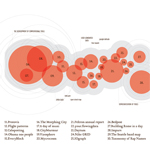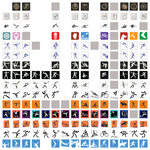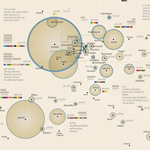Volume IV, Issue 4
With this issue of PJIM we complete our fourth volume, and our sixty-third article. The feedback we've received from our articles and our new website are greatly appreciated. We continue our efforts toward making our articles more comprehensively cross-related and searchable. For this issue we are pleased to present three articles that deal with information design and the process of designing.
For this season’s issue of PJIM we look at an installation that evaluates information design practice with the aim of “providing a systematic view on the discipline.” By considering the origins, impact, and democratization of the field the author looks to possible future trends. The investigation is, in itself, a piece of information design that compellingly integrates the viewpoints with with physical examples. Following the idea of trends and of particular interest to graphic and symbol designers is our next article dealing with Olympic Games pictographs. Few human endeavors have amassed such a collection of symbols created for one event. Today, nearly five hundred symbols have been designed for the Olympic games. The author, through a series of interviews, discussed how the symbols were brought together, analyzed, and scored in order to create diagrams that compared 66 years of pictographic design contextually.
Another major trend in design is the integration of visual language Journalism with Information graphics and information design. If one considers pure textual transmission with headlines as the only graphic call-outs, to text and image and text and diagram, to today's integrated displays of richly supported text this trend is apparent. Will the process evolve to the point where the information design composite is the entirety of the article. Our last contributors lays out the architectonics of creating info-journalism. The text is supported by sublime and aesthetically rich examples of textually rich diagrams that are published as a major feature within a weekly supplement. The trends and methods for the craft of Information Design are expanding rapidly we are pleased to capture some of the insights dealing with the field in the issue.
Jihoon Kang, Publisher, and William Bevington, Editor-in-Chief
Parsons Journal for Information Mapping

The Diagram of Information Visualization
by Gaia Scagnetti, PhD

Trends in Olympic Pictograph Design: A comparative study using Olympic Games’ Sports Symbols
by SoJung Kim

Non-linear Storytelling: Journalism through “Info-spatial” Compositions
by Giorgia Lupi, M.Arch, BFA

